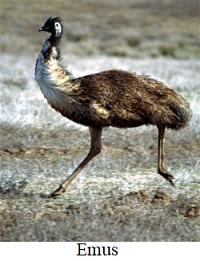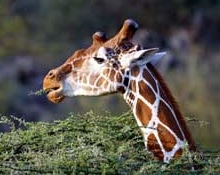 Back during the last ice age, there were beavers the size of black bears living in North America. They weighed about seven times more than beavers do today! Like their modern cousins, these giants were water-lovers, living in and around swamps, lakes, and ponds. They died out when the climate got warmer and the wet places they hung out in disappeared.
Back during the last ice age, there were beavers the size of black bears living in North America. They weighed about seven times more than beavers do today! Like their modern cousins, these giants were water-lovers, living in and around swamps, lakes, and ponds. They died out when the climate got warmer and the wet places they hung out in disappeared.
- Dolphins sleep with one eye open.
- Mosquitoes have 47 teeth.
- The Poison Arrow frog has enough poison to kill 2,200 people.
- Emus can't walk backwards.
- A group of unicorns is called a blessing.
- Flamingos can eat only with their head upside down.
- Raccoons when near water wash their food. I think some of us can learn a thing or two from them regarding hygiene.
- Carpet beetles are great survivors. They can survive inside closed bottles for as long as two ears eating only their discarded skin.
- Mistletoe feeds on the tree it grows on, finally killing it.
- A moth never eats. No, not that it is on a diet. It simply cannot eat since it has neither a mouth nor a stomach.
- Unlike all other insects, flies have five eyes. They have two large eyes and three smaller eyes between them.
- Snails have four noses.
- Penguins can jump 6 feet in the air.
- Snakes can see through their eyelids.
Each year thousands of female green turtles swim more than 1,000 miles from the coast of Brazil to tiny Ascension Island in the South Atlantic Ocean. There they haul themselves onto the sandy beaches, scrape out shallow nests, and deposit their eggs. Then they swim back to Brazil.
 How Giraffes Compensate for Height?
How Giraffes Compensate for Height?
They may reach the foliage in high trees without difficulties, but this comes with its disadvantages. For the blood to reach the head, a heart twice as strong as normal is needed. Also, the blood vessel system should be complex so that the blood doesn’t rush to the head when the giraffe bents over. In addition, the skin of the legs must then be extremely tight to prevent blood from pooling at the hooves.
It is commonly known that the Giraffe is the tallest animal in the world, sometimes reaching a height in excess of 18 feet. Along with it's length neck, the giraffe has a very long tongue – more than a foot and a half long. A giraffe can clean its ears with its 21-inch tongue! Giraffes are the only animals born with horns. Both males and females are born with bony knobs on the forehead.
- A group of kangaroos is called a mob.
- A group of owls is called a parliament.
- A group of ravens is called a murder.
- A group of bears is called a sleuth.
- A baby oyster is called a spat.
- It is possible to lead a cow upstairs but not downstairs.
- A rat can go without water longer than a camel can.
- The fat molecules in goat milk are 5 times smaller than those found in cow milk. It takes 20 minutes for the stomach to breakdown as opposed to the hour that it takes to break down cow milk.
- Chocolate kills dogs! True, chocolate affects a dog's heart and nervous system; a few ounces are enough to kill a small dog
- Tigers can jump up to 10 m (33 ft) in one leap.
- You have heard of the fabled phoenix rising from its ashes but I am sure you haven’t heard of the return of another prodigal – the California Grey Whale. It has returned twice from extinction – once in 1880s and the second time in 1930s.
- During the summer, a blue whale can eat about 40 million krill a day - about 3600 kg.
- The tiger shark may bear as many as 82 living young at one time.
- When in danger some species of the sea cucumbers discharge sticky threads that can entangle predators.
- The Palauan people of the south Pacific squeeze the sea cucumber until it squirts out its sticky thread and then wear them on their feet as protection.
- The eyes of hatchet fish are so large that they can only point upwards so they have to catch all their food from above.
- The hatchet fish has light-producing cells on its belly, which give out a pale blue light that looks like daylight shining through the water.
- Unusually for marsupials, the wombat's pouch faces backwards - it wouldn't be much fun for the Joey if its pouch kept filling up with dirt when mum was digging!.
So why do the frogs have brightly colored bodies and huge red eyes? The bright colors are a defense mechanism. If the green camouflage fails and a predator spots a sleeping frog, it swoops in for what it thinks will be a tasty meal. But the awakened frog’s eyes pop open, revealing their startling bright red color! Also, when the frog rushes to get away, it un-tucks its brightly colored legs.
The predator is often so surprised by these sudden flashes of color that it is momentarily confused and hesitates. And while it does, the frog has a split second to make its escape!
- The stonefish which looks like a stone is one of the most venomous vertebrates known. Its sharp dorsal spines contain enough poison to kill an adult human who is unfortunate enough to step on one.
- Adult male platypuses have a poison gland in their hind legs. They can eject poison out of a hollow, horny spur on their ankle.
- The brown tail moth caterpillar is covered with white and brown hairs. The brown hairs are the ones you have to look out for: They are barbed and contain a poisonous substance, and are frequently carried by the wind. These hairs can cause human respiratory problems and an irritating skin rash.
- One of a centipede's many pairs of legs has especially strong joints and end in a sharp claw into which a poison gland opens. These legs are used for seizing and killing prey. In some species, the bite is poisonous to humans.
- Everyone may have heard of wombats, but they're such secretive little animals we know very little about them. They're difficult to find because they live in highly complex systems of burrows and rarely come out during the day.
- Known for their sharp teeth and insatiable appetites, bluefish migrate in dense packs each spring, preying on other fish that come inshore to spawn. Bluefish often leave a trail of blood for miles as they consume other fish in a feeding frenzy.
- The American golden plover travels about 8,000 miles from nesting areas in the Arctic to the southern tip of South America--one of the longest migrations known. The trip includes about 2,000 miles over Open Ocean.
- Juvenile salmon memorize the odor of the stream in which they were born. Years later they use this knowledge to navigate from the ocean back to the mouth of their home river; they then follow its distinctive odor upstream.
- Dog ownership in North America and Europe has declined for the last decade, while cat ownership has increased.
- The Fitzroy river turtle native to Australia, has a highly (lots of blood vessels) set of sacs at the end of its digestive tract that allows it to take in oxygen through its backside, as well as through its front.
- Like the character Count Dracula and his real-life vampire bat counterparts, a small, East African jumping spider has a taste for blood. The spider, Evarcha Culicivora, lacks the ability to pierce skin and to sip blood, so instead it feeds indirectly on blood by choosing, as its meal, female mosquitoes that have just engorged themselves with a victim's blood. The blood-hungry spider is the first predator ever identified that selects its prey based upon what the prey just ate. Similar to a protein shake, blood can be a highly nutritious drink that goes down smoothly.
 Back during the last ice age, there were beavers the size of black bears living in North America. They weighed about seven times more than beavers do today! Like their modern cousins, these giants were water-lovers, living in and around swamps, lakes, and ponds. They died out when the climate got warmer and the wet places they hung out in disappeared.
Back during the last ice age, there were beavers the size of black bears living in North America. They weighed about seven times more than beavers do today! Like their modern cousins, these giants were water-lovers, living in and around swamps, lakes, and ponds. They died out when the climate got warmer and the wet places they hung out in disappeared. How Giraffes Compensate for Height?
How Giraffes Compensate for Height?